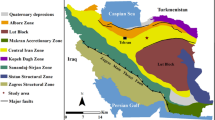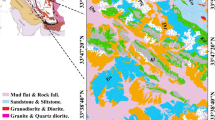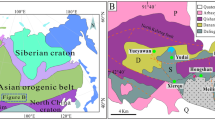Abstract
Accurate ore grade estimation is crucial to mineral resources evaluation and exploration. In this paper, we consider the borehole data collected from the Solwara 1 deposit, where the hydrothermal sulfide ore body is quite complicated with incomplete ore grade values. To solve this estimation problem, the relevance vector machine (RVM) and the expected squared distance (ESD) algorithm are incorporated into one regression model. Moreover, we improve the ESD algorithm by weighting the attributes of the data set and propose the weighted expected squared distance (WESD). In this paper, we uncover the symbiosis characteristics among different elements of the deposits by statistical analysis, which leads to estimating certain metal based on the data of other elements instead of on geographical position. The proposed WESD-RVM features high sparsity and accuracy, as well as the capability of handling incomplete data. Effectiveness of the proposed model is demonstrated by comparing with other estimating algorithms, such as inverse distance weighted method and Kriging algorithm which utilize only geographical spatial coordinates for inputs; extreme learning machine, which is unable to deal with incomplete data; and ordinary ESD based RVM regression model without entropy weighted distance. The experimental results show that the proposed WESD-RVM outperforms other methods with considerable predictive and generalizing ability.





Similar content being viewed by others
Explore related subjects
Discover the latest articles, news and stories from top researchers in related subjects.References
Barakat A (2015) Gold mineralization in the Ourika Gneiss (High Atlas of Marrakech, Morocco): mineral paragenesis and fluid PTX evolution. Arab J Geosci 8(5):3207–3222
Bartier PM, Keller CP (1996) Multivariate interpolation to incorporate thematic surface data using inverse distance weighting (IDW). Comput Geosci 22(7):795–799
Eirola E, Doquire G, Verleysen M, Lendasse A (2013) Distance estimation in numerical data sets with missing values. Inf Sci 240:115–128
He YL, Wang XZ, Huang JZX (2016) Fuzzy nonlinear regression analysis using a random weight network. Inf Sci. doi:10.1016/j.ins.2016.01.037
Hoehun H, Olson JR, Ling B, Rogerson PA (2014) Analysis of heavy metal sources in soil using kriging interpolation on principal components. Environ Sci Technol 48(9):4999–5007
Huang G, Huang GB, Song S, You K (2015) Trends in extreme learning machines: a review. Neural Netw 61:32–48
Huang GB, Zhou H, Ding X, Zhang R (2012) Extreme learning machine for regression and multiclass classification. IEEE Trans Syst Man Cybern Part B Cybern A Publ IEEE Syst Man Cybern Soc 42(42):513–529
Huang GB, Zhu QY, Siew CK (2006) Extreme learning machine: theory and applications. Neurocomputing 70(1–3):489–501
Kapageridis I K, Denby B, Hunter G (1999) Integration of a neural ore grade estimation tool in a 3D resource modeling package. In: Neural Networks, 1999. International Joint Conference on IJCNN ’99, vol 6, pp 3908–3912
Li ZX, Li X, Li CP, Cao Z (2010) Improvement on inverse distance weighted interpolation for ore reserve estimation. In: Fuzzy systems and knowledge discovery (FSKD), 2010 Seventh International Conference on, pp 1703–1706
Little RJ, Rubin DB (2014) Statistical analysis with missing data. Wiley, pp 11–19
Lu S, Wang X, Zhang G, Zhou X (2015) Effective algorithms of the Moore-Penrose inverse matrices for extreme learning machine. Intell Data Anal 19(4):743–760
Mahmoudabadi H, Izadi M, Menhaj MB (2009) A hybrid method for grade estimation using genetic algorithm and neural networks. Comput Geosci 13(1):91–101
Meng XL, Rubin DB (1993) Maximum likelihood estimation via the ECM algorithm: a general framework. Biometrika 80(2):267–278
Mon DL (1995) Evaluating weapon system using fuzzy analytic hierarchy process based on entropy weight. In: Fuzzy systems, 1995. International joint conference of the fourth IEEE international conference on fuzzy systems and the second international fuzzy engineering symposium, Proceedings of 1995 IEEE Int. IEEE, vol 2, pp 591–598
Qiang WU, Hua XU (2014) Three-dimensional geological modeling and its application in Digital Mine. Sci China Earth Sci 57(03):491–502
Rodriguez A, Laio A (2014) Machine learning. Clustering by fast search and find of density peaks. Science 344(6191):1492–1496
Samanta B (2002) Data segmentation and genetic algorithms for sparse data division in nome placer gold grade estimation using neural network and geostatistics. Explor Min Geol 11:69–76
Samanta B (2010) Radial basis function network for rre grade estimation. Nat Resour Res 19(2):91–102
Schmidt WF, Kraaijveld MA, Duin RPW (1992) Feedforward neural networks with random weights. In: Pattern recognition, 1992. Vol II. Conference B: Pattern recognition methodology and systems, proceedings, 11th IAPR International Conference on, pp 1–4
Sexton J, Swensen AR (2000) ECM algorithms that converge at the rate of EM. Biometrika 87(3): 651–662
Shannon CE (1948) A mathematical theory of communication. Bell Syst Tech J 27(3):379–423
Simpson TW, Mauery TM, Korte JJ, Mistree F (2001) Kriging models for global approximation in simulation-based multidisciplinary design optimization. AIAA J 39(12):2233–2241
Stephenson J, Gallagher K, Holmes C (2004) Beyond kriging: dealing with discontinuous spatial data fields using adaptive prior information and Bayesian partition modelling. Geol Soc Lond Spec Publ 239(1):195–209
Tipping ME (2001) Sparse Bayesian learning and the relevance vector machine. J Mach Learn Res 1:211–244
Trista D, Kojima S (2003) Mineral paragenesis and fluid inclusions of some pluton-hosted vein-type copper deposits in the coastal cordillera, northern Chile. Resource Geology 53(1):21–28
Wang X (2015) Uncertainty in learning from big data-editorial. J Intell Fuzzy Syst 28(5):2329–2330
Wang XZ, Aamir Raza Ashfaq R, Fu AM (2015a) Fuzziness based sample categorization for classifier performance improvement. J Intell Fuzzy Syst 29(3):1185–1196
Wang XZ, Xing HJ, Li Y, Hua Q, Dong CR, Pedrycz W (2015b) A study on relationship between generalization abilities and fuzziness of base classifiers in ensemble learning. Fuzzy Syst IEEE Trans 23(5):1638–1654
Zhang XN, Song SJ, Li JB, Wu C (2013) Robust LS-SVM regression for ore grade estimation in a seafloor hydrothermal sulphide deposit. Acta Oceanol Sin 32(8):16–25
Acknowledgments
This research has been supported by the Major Program of the National Natural Science Foundation of China under Grant 41427806, and by the Project of China Ocean Association under Grant DYXM-125-25-02.
Author information
Authors and Affiliations
Corresponding author
Ethics declarations
We declare that we have no conflict of interest. This article does not contain any studies with human participants or animals performed by any of the authors.
Rights and permissions
About this article
Cite this article
Zhang, Y., Song, S., You, K. et al. Relevance vector machines using weighted expected squared distance for ore grade estimation with incomplete data. Int. J. Mach. Learn. & Cyber. 8, 1655–1666 (2017). https://doi.org/10.1007/s13042-016-0535-x
Received:
Accepted:
Published:
Issue Date:
DOI: https://doi.org/10.1007/s13042-016-0535-x




